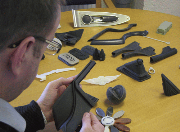 There’s a paradox in the automotive industry. Despite luxury cars commanding much higher prices than regular vehicles, the available budget to achieve that luxury is less than for a normal car. The performance of each component and its perceived value, however, needs to be much higher than is required on a design for the lower end of the market. Kevin Stibbards, managing director at seal manufacturer Gti Corporation, explains how the company uses 3D printers, provided by Objet Printer Solutions (OPS), to help meet the high standards required
There’s a paradox in the automotive industry. Despite luxury cars commanding much higher prices than regular vehicles, the available budget to achieve that luxury is less than for a normal car. The performance of each component and its perceived value, however, needs to be much higher than is required on a design for the lower end of the market. Kevin Stibbards, managing director at seal manufacturer Gti Corporation, explains how the company uses 3D printers, provided by Objet Printer Solutions (OPS), to help meet the high standards required
The sheer scale on which mass market cars are produced means that the overall revenue a single design generates is in an entirely different league to that of a high-end vehicle. For luxury vehicles, component performance and its perceived value is higher, so to meet these demands Gti Corporation is using 3D printers.
 The company designs and manufactures tooling for rubber sealing systems, such as automotive door and window seals; and one of its key advantages is that it provides both an in-house tool room and a manufacturing facility.
The company designs and manufactures tooling for rubber sealing systems, such as automotive door and window seals; and one of its key advantages is that it provides both an in-house tool room and a manufacturing facility.
Principle customers include Alfa Romeo and Aston Martin, and its efficient business model and structure has contributed to it maintaining the high standards and assured quality required by the automotive industry.
The Objet Connex 350 3D printer is being used to produce prototypes for seals, enabling its customers to reach market more quickly. Before the printer was installed, the company used a Stereolithography process to develop a master and then used vacuum casting to create a model. The entire process would have taken anywhere between one and three weeks to achieve, depending on the complexity of the design.
Building parts
 3D printing is a form of additive manufacturing where a three dimensional object is created by laying down successive layers of material on a machine visually similar to a large desktop printer. As a result, Gti and its customers can verify the design more quickly than if they were using prototype methods.
3D printing is a form of additive manufacturing where a three dimensional object is created by laying down successive layers of material on a machine visually similar to a large desktop printer. As a result, Gti and its customers can verify the design more quickly than if they were using prototype methods.
The mixed material function of the Connex 350 means multiple parts can be printed using different materials in a single build. These materials can include a host of properties and tones as well as composites. The machine provides a very convincing simulation of the end product using simultaneous jetting of different model materials at an incredible 16 micron resolution, which ensures a smooth surface and fine details.
Getting it right first time
Of additional benefit to the company, the 3D printer has a build tray measuring 350 x 350 x 200mm, making it suitable for a wide range of parts and assemblies, including printing prototypes for relatively large seals in-house.
“With the Objet machine, we are able to take the prototype of the design to the customer the very next day, instead of making them wait for a couple of weeks,” explained Kevin Strachan, business development manager. “Similarly, for show cars we can produce an item using the Connex 350 that looks and feels like a production model in a couple of days, emulating rubber in various different grades.”
So, in addition to speeding up the process, 3D printing also helps Gti’s OEM partners save money by increasing the chance of getting it right first time. 3D prototyping can also reduce the number of iterations in the design loop which allows modifications to be processed without re-tooling.
“Modifications normally follow a fit and build trial process,” explained Strachan. “But the cost of getting it wrong isn’t only the cost of the modification. One also has to consider the knock-on effect on the OEM’s timing plan, especially if there are multiple products in the process. In addition, 3D printing can reduce the costs of the verification procedure and allow a component to be released for testing much sooner than would otherwise have been possible.”
Competing in a globalised market
OPS believes that it is technical innovation, such as the use of 3D printing in prototyping, that allows agile businesses like Gti Corporation to compete in a heavily globalised market, providing the finish required in luxury vehicles irrespective of the budget. The lesson is applicable across multiple industries in which the market appears to present a paradox – or contradiction between the required standard of service and the means available to achieve it.
“Gti is a great example of engineering in its purest sense,” explained Andrew Fulton, managing director of OPS UK. “It achieves something more efficiently and to a higher standard than the next company by thinking its way to a solution. For me, that’s what engineering is all about.”
OPS
T: 01283 585955

